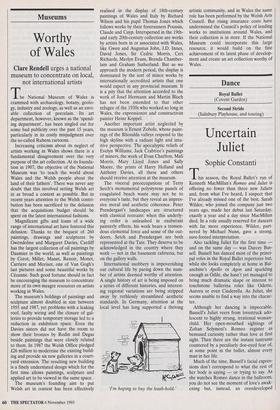Museums
Worthy of Wales
Clare Rendell urges a national museum to concentrate on local, not international artists
The National Museum of Wales is crammed with archaeology, botany, geolo- gy, industry and zoology, as well as an envi- able collection of porcelain. Its art department, however, known as the 'spend- ing department', has been singled out for some bad publicity over the past 15 years, particularly in its costly misjudgment over the so-called Rubens cartoons.
Increasing criticism about its neglect of artists working in Wales shows there is a fundamental disagreement over the very purpose of the art collection. At its founda- tion in 1907, the objective of the National Museum was 'to teach the world about Wales and the Welsh people about the land of their fathers'. There was never any doubt that this involved setting Welsh art in as broad a context as possible. But in recent years attention to the Welsh contri- bution has been sacrificed to the delusion that the acquisitions budget should be spent on the latest international fashions.
Magnificent gifts and loans of a wide range of international art have fostered this delusion. Thanks to the bequest of 260 paintings, drawings and sculptures by Gwendoline and Margaret Davies, Cardiff has the largest collection of oil paintings by Daumier in the world, as well as paintings by Corot, Millet, Manet, Renoir, Monet, Carriere and Morisot, one of Van Gogh's last pictures and some beautiful works by Cezanne. Such good fortune should in fact be encouraging the museum to concentrate more of its own meagre resources on artists working in Wales.
The museum's holdings of paintings and sculpture almost doubled in size between 1955 and 1987, yet problems with a leaking roof, faulty wiring and the closure of gal- leries to provide temporary storage led to a reduction in exhibition space. Even the Davies sisters did not have the room to show their bronzes by Rodin and Degas beside paintings that were closely related to them. In 1987 the Welsh Office pledged £26 million to modernise the existing build- ing and provide six new galleries in a court- yard extension. The resulting new building is a finely understated design which for the first time allows paintings, sculpture and applied art to be viewed in the same space.
The museum's founding aim to put Welsh art in context has been effectively realised in the display of 18th-century paintings of Wales and Italy by Richard Wilson and his pupil Thomas Jones which follows works by their forerunners Poussin, Claude and Cuyp. Interspersed in the 19th- and early 20th-century collection are works by artists born in or associated with Wales, like Gwen and Augustus John, J.D. Innes, David Jones, Sir Cedric Morris, Ceri Richards, Merlyn Evans, Brenda Chamber- lain and Graham Sutherland. But as we approach the modern period, the display is dominated by the sort of minor works by internationally accredited artists that one would expect in any provincial museum. It is a pity that the attention accorded to the work of Josef Hermann and Martin Bloch has not been extended to that other refugee of the 1930s who worked so long in Wales, the expressionist and constructivist painter Heinz Koppel.
Another important artist neglected by the museum is Ernest Zobole, whose paint- ings of the Rhondda valleys respond to the high skyline with a radiant light and intu- itive perspective. The apocalyptic reliefs of Evelyn Williams, Jack Crabtree's paintings of miners, the work of Evan Charlton, Mali Morris, Mary Lloyd Jones and Sally Moore, the prints of Harry Holland and Anthony Davies, all these and others should receive attention at the museum.
The visceral preoccupations of Terry Setch's monumental polystyrene panels of coagulated beach waste may not be to everyone's taste, but they reveal an impres- sive moral and aesthetic coherence. Peter Prendergast's landscapes are structured with classical restraint: when this underly- ing order is unleashed in exuberant painterly effects, his work bears a tremen- dous elemental force and sense of the out- doors. Setch and Prendergast are both represented at the Tate. They deserve to be acknowledged in the country where they work — not in the basement cafeteria, but on the gallery walls.
International snobbery is impoverishing our cultural life by paring down the num- ber of artists deemed worthy of attention. A single history of art is being imposed on a series of different histories, and interest- ing regional variations are being stripped away by ruthlessly streamlined aesthetic standards. In Germany, attention at the local level has long supported a thriving 'I'm hoping to buy the leash-hold.' artistic community, and in Wales the same role has been performed by the Welsh Arts Council. But rising insurance costs have undermined the Council's policy of lending works to institutions around Wales, and their collection is in store. If the National Museum could incorporate this large resource, it would build on the fine achievement of its latest phase of develop- ment and create an art collection worthy of Wales.










































































 Previous page
Previous page